Employee Engagement and Sustainability: A Leadership Perspective
VerifiedAdded on 2022/11/23
|11
|2900
|213
Report
AI Summary
This report delves into the critical relationship between employee engagement and sustainability within organizations, emphasizing the pivotal role of leadership. It examines how leaders perceive the value of sustainability in fostering employee engagement, highlighting factors such as transparency in expectations, encouragement, and supportive work environments. The discussion covers the impact of rewards, recognition, and appraisal systems, as well as the importance of training and educational programs. The report also explores theoretical concepts like attachment theory and social identity theory to explain the link between employee behavior, sustainability, and CSR activities. Furthermore, it emphasizes the benefits of employee engagement, including increased motivation, job satisfaction, and organizational success. The conclusion underscores the necessity of integrating sustainability into organizational strategies and operations, providing actionable insights for leaders to enhance employee involvement and drive positive environmental and social outcomes. The report cites several research papers and studies to support its claims.
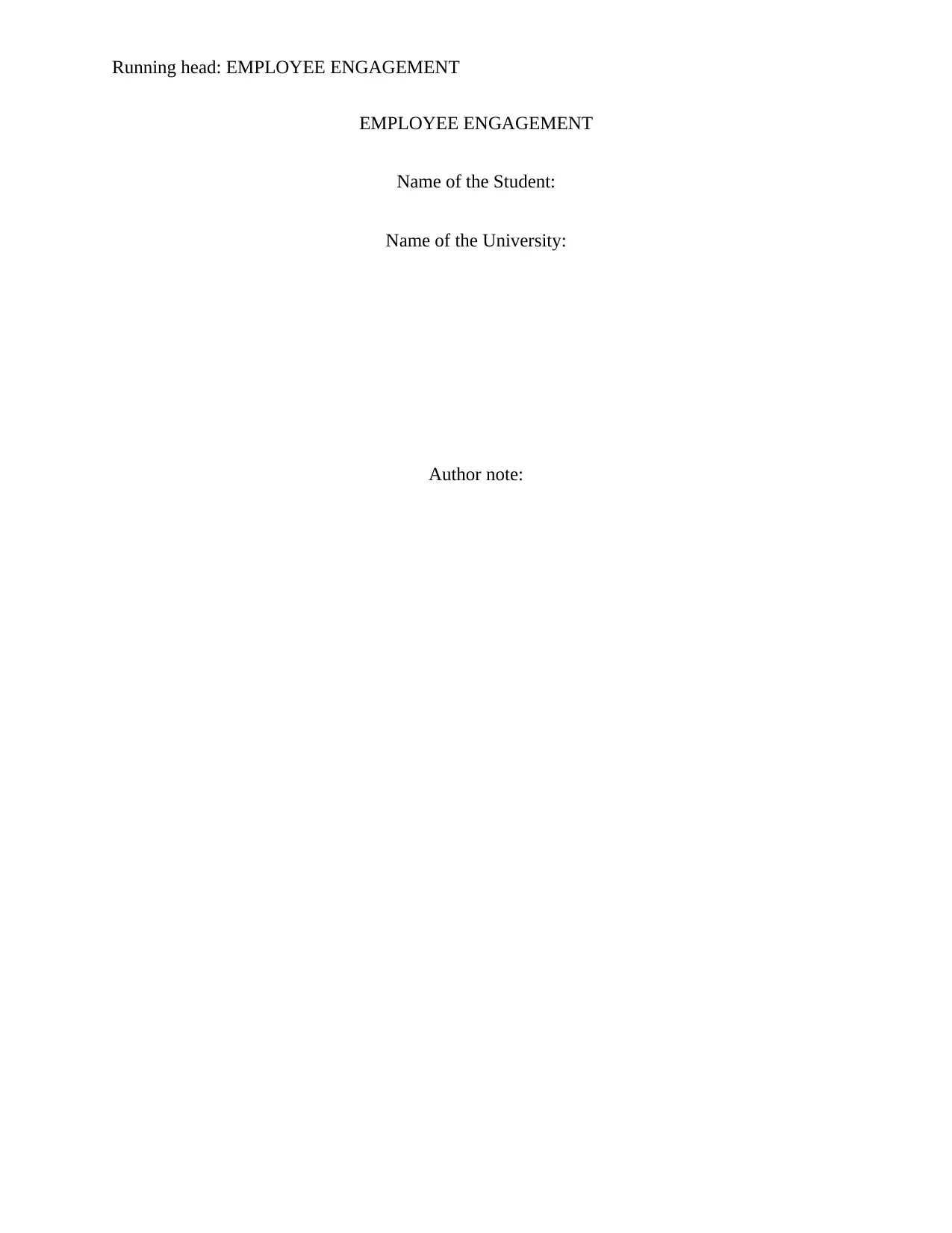
Running head: EMPLOYEE ENGAGEMENT
EMPLOYEE ENGAGEMENT
Name of the Student:
Name of the University:
Author note:
EMPLOYEE ENGAGEMENT
Name of the Student:
Name of the University:
Author note:
Paraphrase This Document
Need a fresh take? Get an instant paraphrase of this document with our AI Paraphraser
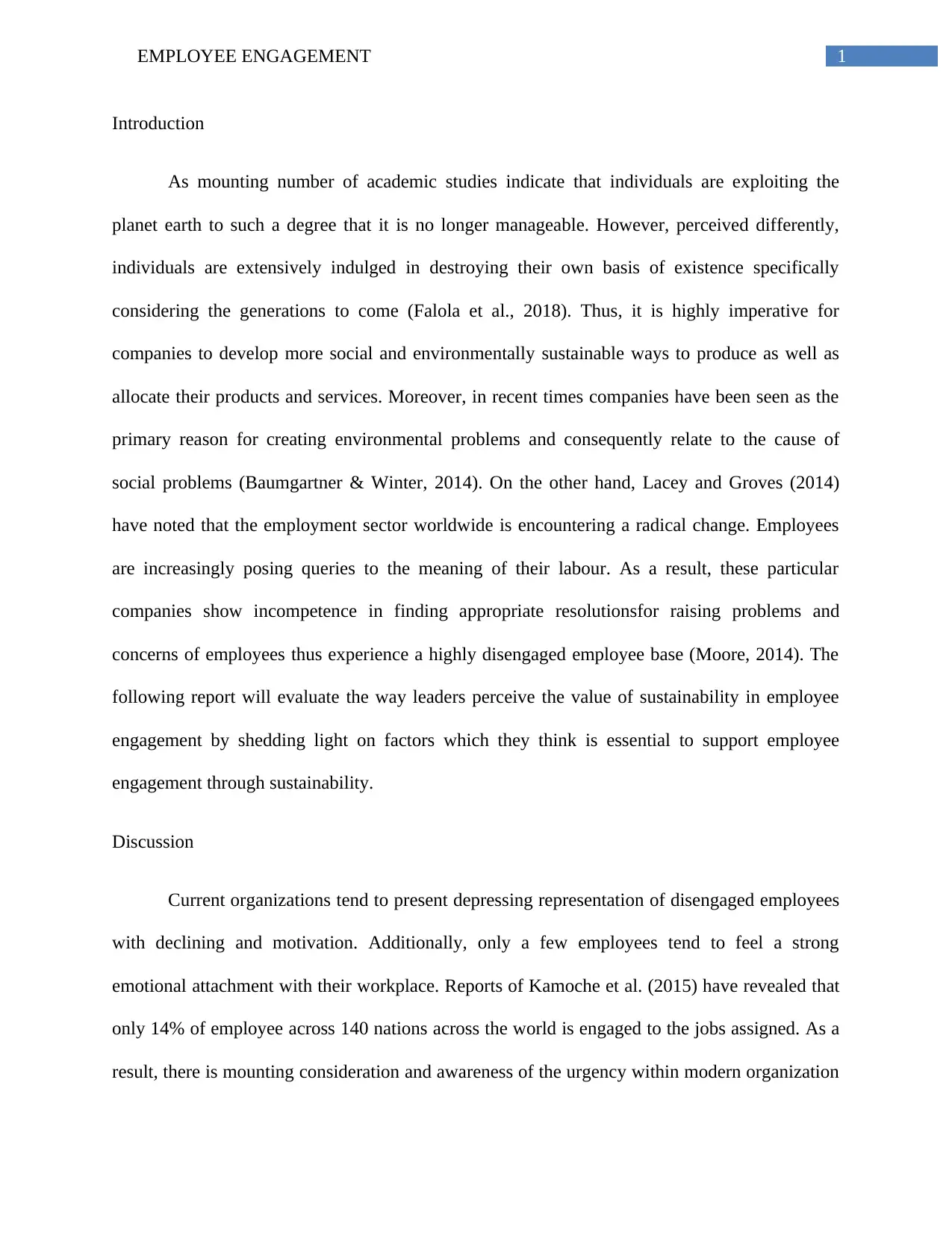
1EMPLOYEE ENGAGEMENT
Introduction
As mounting number of academic studies indicate that individuals are exploiting the
planet earth to such a degree that it is no longer manageable. However, perceived differently,
individuals are extensively indulged in destroying their own basis of existence specifically
considering the generations to come (Falola et al., 2018). Thus, it is highly imperative for
companies to develop more social and environmentally sustainable ways to produce as well as
allocate their products and services. Moreover, in recent times companies have been seen as the
primary reason for creating environmental problems and consequently relate to the cause of
social problems (Baumgartner & Winter, 2014). On the other hand, Lacey and Groves (2014)
have noted that the employment sector worldwide is encountering a radical change. Employees
are increasingly posing queries to the meaning of their labour. As a result, these particular
companies show incompetence in finding appropriate resolutionsfor raising problems and
concerns of employees thus experience a highly disengaged employee base (Moore, 2014). The
following report will evaluate the way leaders perceive the value of sustainability in employee
engagement by shedding light on factors which they think is essential to support employee
engagement through sustainability.
Discussion
Current organizations tend to present depressing representation of disengaged employees
with declining and motivation. Additionally, only a few employees tend to feel a strong
emotional attachment with their workplace. Reports of Kamoche et al. (2015) have revealed that
only 14% of employee across 140 nations across the world is engaged to the jobs assigned. As a
result, there is mounting consideration and awareness of the urgency within modern organization
Introduction
As mounting number of academic studies indicate that individuals are exploiting the
planet earth to such a degree that it is no longer manageable. However, perceived differently,
individuals are extensively indulged in destroying their own basis of existence specifically
considering the generations to come (Falola et al., 2018). Thus, it is highly imperative for
companies to develop more social and environmentally sustainable ways to produce as well as
allocate their products and services. Moreover, in recent times companies have been seen as the
primary reason for creating environmental problems and consequently relate to the cause of
social problems (Baumgartner & Winter, 2014). On the other hand, Lacey and Groves (2014)
have noted that the employment sector worldwide is encountering a radical change. Employees
are increasingly posing queries to the meaning of their labour. As a result, these particular
companies show incompetence in finding appropriate resolutionsfor raising problems and
concerns of employees thus experience a highly disengaged employee base (Moore, 2014). The
following report will evaluate the way leaders perceive the value of sustainability in employee
engagement by shedding light on factors which they think is essential to support employee
engagement through sustainability.
Discussion
Current organizations tend to present depressing representation of disengaged employees
with declining and motivation. Additionally, only a few employees tend to feel a strong
emotional attachment with their workplace. Reports of Kamoche et al. (2015) have revealed that
only 14% of employee across 140 nations across the world is engaged to the jobs assigned. As a
result, there is mounting consideration and awareness of the urgency within modern organization
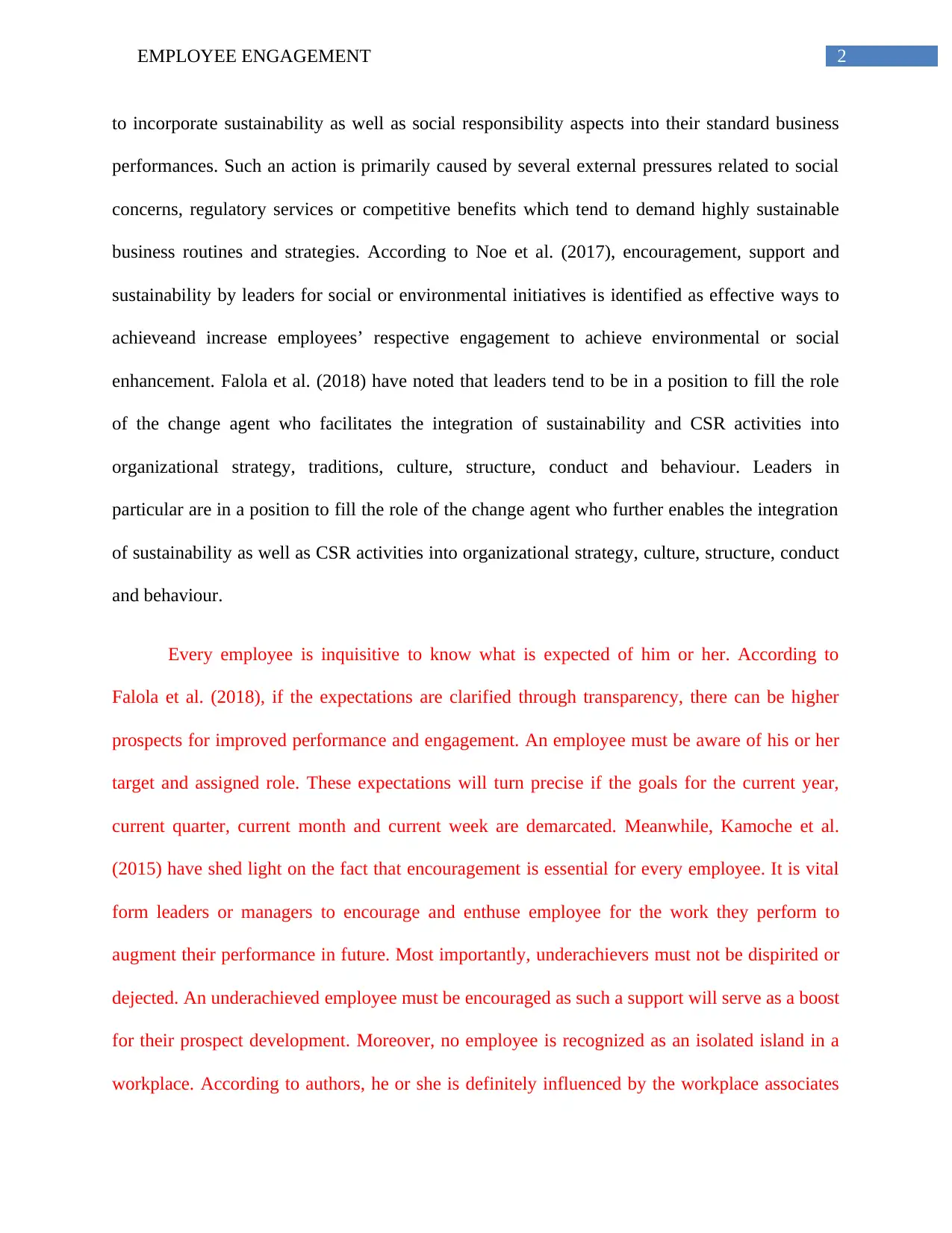
2EMPLOYEE ENGAGEMENT
to incorporate sustainability as well as social responsibility aspects into their standard business
performances. Such an action is primarily caused by several external pressures related to social
concerns, regulatory services or competitive benefits which tend to demand highly sustainable
business routines and strategies. According to Noe et al. (2017), encouragement, support and
sustainability by leaders for social or environmental initiatives is identified as effective ways to
achieveand increase employees’ respective engagement to achieve environmental or social
enhancement. Falola et al. (2018) have noted that leaders tend to be in a position to fill the role
of the change agent who facilitates the integration of sustainability and CSR activities into
organizational strategy, traditions, culture, structure, conduct and behaviour. Leaders in
particular are in a position to fill the role of the change agent who further enables the integration
of sustainability as well as CSR activities into organizational strategy, culture, structure, conduct
and behaviour.
Every employee is inquisitive to know what is expected of him or her. According to
Falola et al. (2018), if the expectations are clarified through transparency, there can be higher
prospects for improved performance and engagement. An employee must be aware of his or her
target and assigned role. These expectations will turn precise if the goals for the current year,
current quarter, current month and current week are demarcated. Meanwhile, Kamoche et al.
(2015) have shed light on the fact that encouragement is essential for every employee. It is vital
form leaders or managers to encourage and enthuse employee for the work they perform to
augment their performance in future. Most importantly, underachievers must not be dispirited or
dejected. An underachieved employee must be encouraged as such a support will serve as a boost
for their prospect development. Moreover, no employee is recognized as an isolated island in a
workplace. According to authors, he or she is definitely influenced by the workplace associates
to incorporate sustainability as well as social responsibility aspects into their standard business
performances. Such an action is primarily caused by several external pressures related to social
concerns, regulatory services or competitive benefits which tend to demand highly sustainable
business routines and strategies. According to Noe et al. (2017), encouragement, support and
sustainability by leaders for social or environmental initiatives is identified as effective ways to
achieveand increase employees’ respective engagement to achieve environmental or social
enhancement. Falola et al. (2018) have noted that leaders tend to be in a position to fill the role
of the change agent who facilitates the integration of sustainability and CSR activities into
organizational strategy, traditions, culture, structure, conduct and behaviour. Leaders in
particular are in a position to fill the role of the change agent who further enables the integration
of sustainability as well as CSR activities into organizational strategy, culture, structure, conduct
and behaviour.
Every employee is inquisitive to know what is expected of him or her. According to
Falola et al. (2018), if the expectations are clarified through transparency, there can be higher
prospects for improved performance and engagement. An employee must be aware of his or her
target and assigned role. These expectations will turn precise if the goals for the current year,
current quarter, current month and current week are demarcated. Meanwhile, Kamoche et al.
(2015) have shed light on the fact that encouragement is essential for every employee. It is vital
form leaders or managers to encourage and enthuse employee for the work they perform to
augment their performance in future. Most importantly, underachievers must not be dispirited or
dejected. An underachieved employee must be encouraged as such a support will serve as a boost
for their prospect development. Moreover, no employee is recognized as an isolated island in a
workplace. According to authors, he or she is definitely influenced by the workplace associates
⊘ This is a preview!⊘
Do you want full access?
Subscribe today to unlock all pages.

Trusted by 1+ million students worldwide
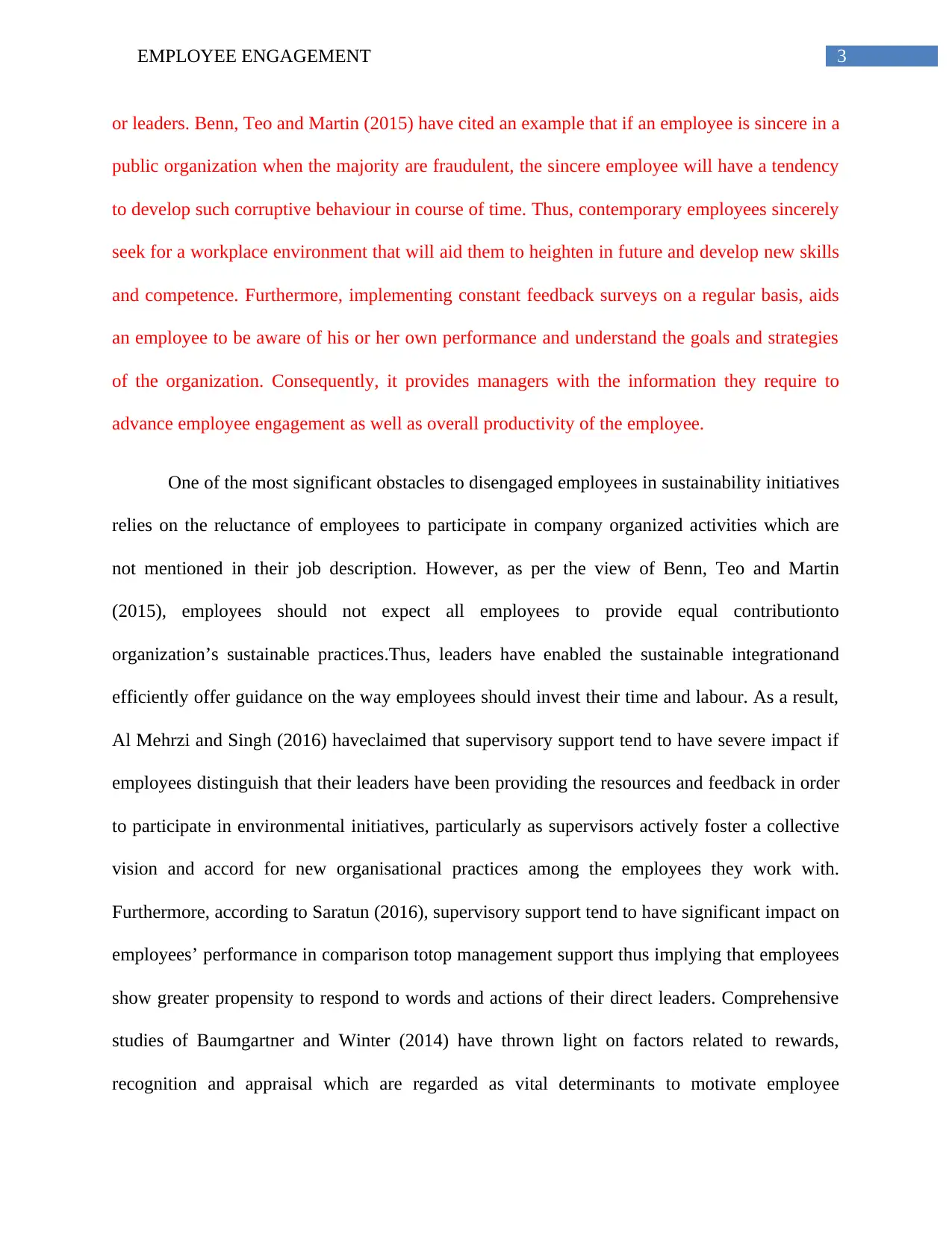
3EMPLOYEE ENGAGEMENT
or leaders. Benn, Teo and Martin (2015) have cited an example that if an employee is sincere in a
public organization when the majority are fraudulent, the sincere employee will have a tendency
to develop such corruptive behaviour in course of time. Thus, contemporary employees sincerely
seek for a workplace environment that will aid them to heighten in future and develop new skills
and competence. Furthermore, implementing constant feedback surveys on a regular basis, aids
an employee to be aware of his or her own performance and understand the goals and strategies
of the organization. Consequently, it provides managers with the information they require to
advance employee engagement as well as overall productivity of the employee.
One of the most significant obstacles to disengaged employees in sustainability initiatives
relies on the reluctance of employees to participate in company organized activities which are
not mentioned in their job description. However, as per the view of Benn, Teo and Martin
(2015), employees should not expect all employees to provide equal contributionto
organization’s sustainable practices.Thus, leaders have enabled the sustainable integrationand
efficiently offer guidance on the way employees should invest their time and labour. As a result,
Al Mehrzi and Singh (2016) haveclaimed that supervisory support tend to have severe impact if
employees distinguish that their leaders have been providing the resources and feedback in order
to participate in environmental initiatives, particularly as supervisors actively foster a collective
vision and accord for new organisational practices among the employees they work with.
Furthermore, according to Saratun (2016), supervisory support tend to have significant impact on
employees’ performance in comparison totop management support thus implying that employees
show greater propensity to respond to words and actions of their direct leaders. Comprehensive
studies of Baumgartner and Winter (2014) have thrown light on factors related to rewards,
recognition and appraisal which are regarded as vital determinants to motivate employee
or leaders. Benn, Teo and Martin (2015) have cited an example that if an employee is sincere in a
public organization when the majority are fraudulent, the sincere employee will have a tendency
to develop such corruptive behaviour in course of time. Thus, contemporary employees sincerely
seek for a workplace environment that will aid them to heighten in future and develop new skills
and competence. Furthermore, implementing constant feedback surveys on a regular basis, aids
an employee to be aware of his or her own performance and understand the goals and strategies
of the organization. Consequently, it provides managers with the information they require to
advance employee engagement as well as overall productivity of the employee.
One of the most significant obstacles to disengaged employees in sustainability initiatives
relies on the reluctance of employees to participate in company organized activities which are
not mentioned in their job description. However, as per the view of Benn, Teo and Martin
(2015), employees should not expect all employees to provide equal contributionto
organization’s sustainable practices.Thus, leaders have enabled the sustainable integrationand
efficiently offer guidance on the way employees should invest their time and labour. As a result,
Al Mehrzi and Singh (2016) haveclaimed that supervisory support tend to have severe impact if
employees distinguish that their leaders have been providing the resources and feedback in order
to participate in environmental initiatives, particularly as supervisors actively foster a collective
vision and accord for new organisational practices among the employees they work with.
Furthermore, according to Saratun (2016), supervisory support tend to have significant impact on
employees’ performance in comparison totop management support thus implying that employees
show greater propensity to respond to words and actions of their direct leaders. Comprehensive
studies of Baumgartner and Winter (2014) have thrown light on factors related to rewards,
recognition and appraisal which are regarded as vital determinants to motivate employee
Paraphrase This Document
Need a fresh take? Get an instant paraphrase of this document with our AI Paraphraser
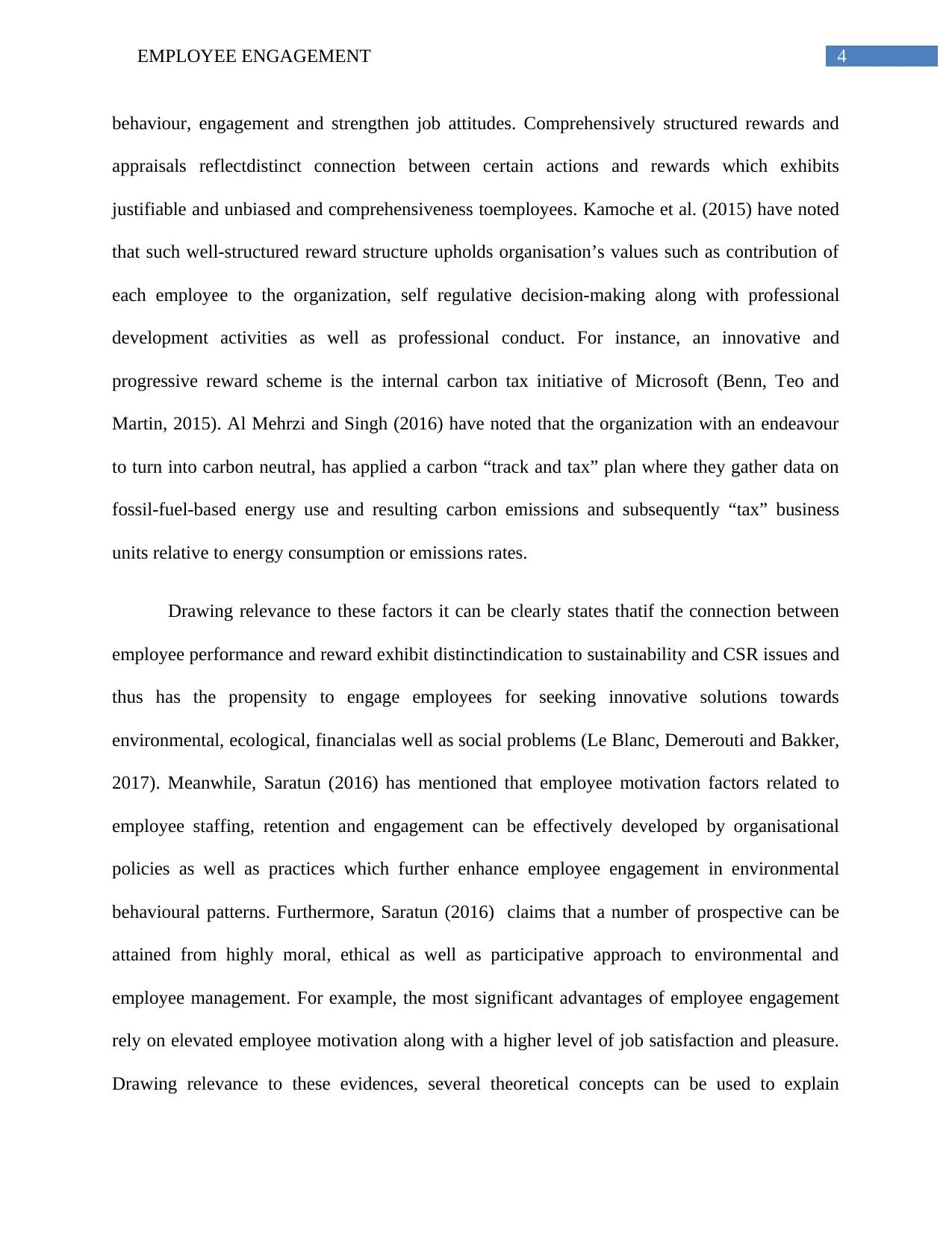
4EMPLOYEE ENGAGEMENT
behaviour, engagement and strengthen job attitudes. Comprehensively structured rewards and
appraisals reflectdistinct connection between certain actions and rewards which exhibits
justifiable and unbiased and comprehensiveness toemployees. Kamoche et al. (2015) have noted
that such well-structured reward structure upholds organisation’s values such as contribution of
each employee to the organization, self regulative decision-making along with professional
development activities as well as professional conduct. For instance, an innovative and
progressive reward scheme is the internal carbon tax initiative of Microsoft (Benn, Teo and
Martin, 2015). Al Mehrzi and Singh (2016) have noted that the organization with an endeavour
to turn into carbon neutral, has applied a carbon “track and tax” plan where they gather data on
fossil-fuel-based energy use and resulting carbon emissions and subsequently “tax” business
units relative to energy consumption or emissions rates.
Drawing relevance to these factors it can be clearly states thatif the connection between
employee performance and reward exhibit distinctindication to sustainability and CSR issues and
thus has the propensity to engage employees for seeking innovative solutions towards
environmental, ecological, financialas well as social problems (Le Blanc, Demerouti and Bakker,
2017). Meanwhile, Saratun (2016) has mentioned that employee motivation factors related to
employee staffing, retention and engagement can be effectively developed by organisational
policies as well as practices which further enhance employee engagement in environmental
behavioural patterns. Furthermore, Saratun (2016) claims that a number of prospective can be
attained from highly moral, ethical as well as participative approach to environmental and
employee management. For example, the most significant advantages of employee engagement
rely on elevated employee motivation along with a higher level of job satisfaction and pleasure.
Drawing relevance to these evidences, several theoretical concepts can be used to explain
behaviour, engagement and strengthen job attitudes. Comprehensively structured rewards and
appraisals reflectdistinct connection between certain actions and rewards which exhibits
justifiable and unbiased and comprehensiveness toemployees. Kamoche et al. (2015) have noted
that such well-structured reward structure upholds organisation’s values such as contribution of
each employee to the organization, self regulative decision-making along with professional
development activities as well as professional conduct. For instance, an innovative and
progressive reward scheme is the internal carbon tax initiative of Microsoft (Benn, Teo and
Martin, 2015). Al Mehrzi and Singh (2016) have noted that the organization with an endeavour
to turn into carbon neutral, has applied a carbon “track and tax” plan where they gather data on
fossil-fuel-based energy use and resulting carbon emissions and subsequently “tax” business
units relative to energy consumption or emissions rates.
Drawing relevance to these factors it can be clearly states thatif the connection between
employee performance and reward exhibit distinctindication to sustainability and CSR issues and
thus has the propensity to engage employees for seeking innovative solutions towards
environmental, ecological, financialas well as social problems (Le Blanc, Demerouti and Bakker,
2017). Meanwhile, Saratun (2016) has mentioned that employee motivation factors related to
employee staffing, retention and engagement can be effectively developed by organisational
policies as well as practices which further enhance employee engagement in environmental
behavioural patterns. Furthermore, Saratun (2016) claims that a number of prospective can be
attained from highly moral, ethical as well as participative approach to environmental and
employee management. For example, the most significant advantages of employee engagement
rely on elevated employee motivation along with a higher level of job satisfaction and pleasure.
Drawing relevance to these evidences, several theoretical concepts can be used to explain
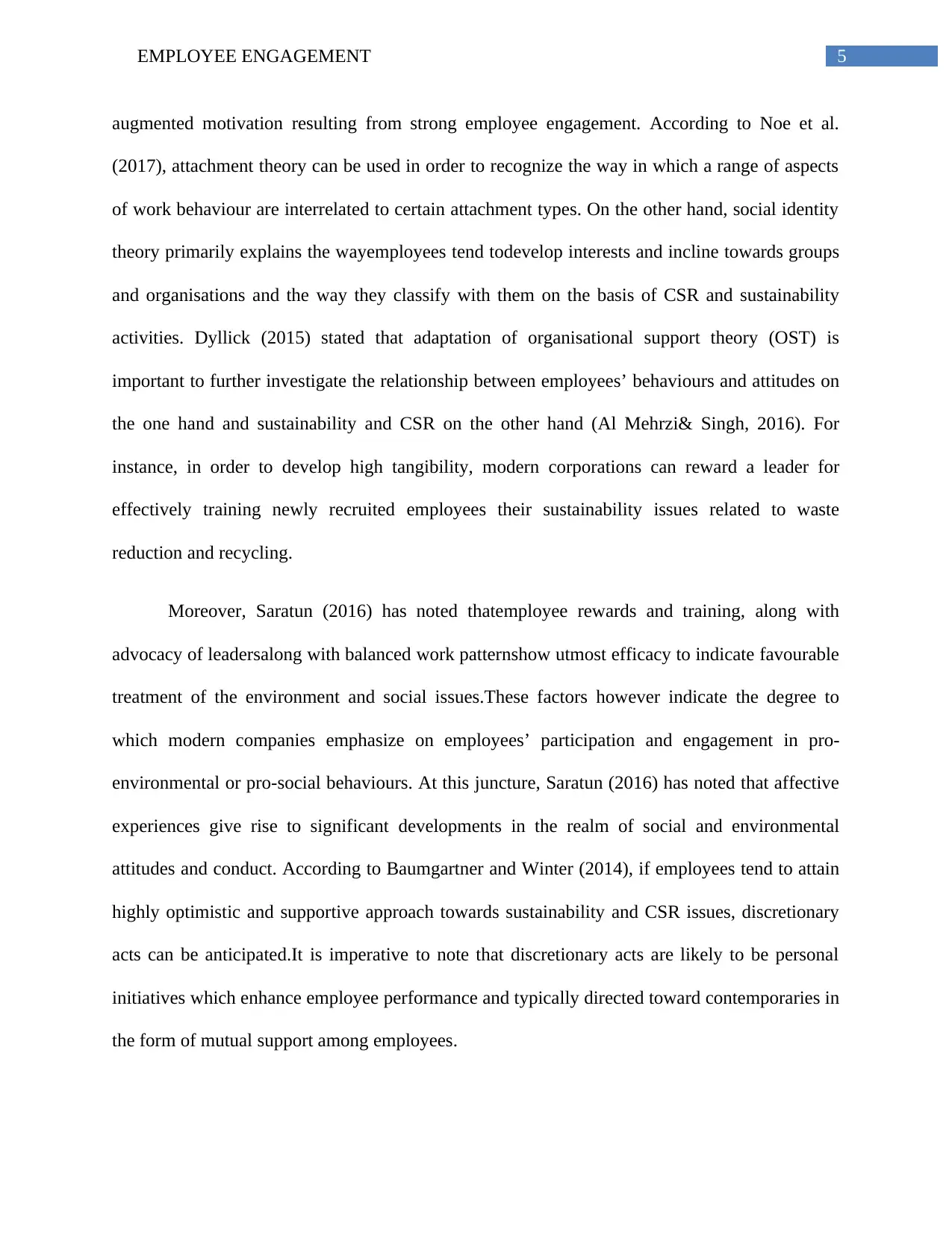
5EMPLOYEE ENGAGEMENT
augmented motivation resulting from strong employee engagement. According to Noe et al.
(2017), attachment theory can be used in order to recognize the way in which a range of aspects
of work behaviour are interrelated to certain attachment types. On the other hand, social identity
theory primarily explains the wayemployees tend todevelop interests and incline towards groups
and organisations and the way they classify with them on the basis of CSR and sustainability
activities. Dyllick (2015) stated that adaptation of organisational support theory (OST) is
important to further investigate the relationship between employees’ behaviours and attitudes on
the one hand and sustainability and CSR on the other hand (Al Mehrzi& Singh, 2016). For
instance, in order to develop high tangibility, modern corporations can reward a leader for
effectively training newly recruited employees their sustainability issues related to waste
reduction and recycling.
Moreover, Saratun (2016) has noted thatemployee rewards and training, along with
advocacy of leadersalong with balanced work patternshow utmost efficacy to indicate favourable
treatment of the environment and social issues.These factors however indicate the degree to
which modern companies emphasize on employees’ participation and engagement in pro-
environmental or pro-social behaviours. At this juncture, Saratun (2016) has noted that affective
experiences give rise to significant developments in the realm of social and environmental
attitudes and conduct. According to Baumgartner and Winter (2014), if employees tend to attain
highly optimistic and supportive approach towards sustainability and CSR issues, discretionary
acts can be anticipated.It is imperative to note that discretionary acts are likely to be personal
initiatives which enhance employee performance and typically directed toward contemporaries in
the form of mutual support among employees.
augmented motivation resulting from strong employee engagement. According to Noe et al.
(2017), attachment theory can be used in order to recognize the way in which a range of aspects
of work behaviour are interrelated to certain attachment types. On the other hand, social identity
theory primarily explains the wayemployees tend todevelop interests and incline towards groups
and organisations and the way they classify with them on the basis of CSR and sustainability
activities. Dyllick (2015) stated that adaptation of organisational support theory (OST) is
important to further investigate the relationship between employees’ behaviours and attitudes on
the one hand and sustainability and CSR on the other hand (Al Mehrzi& Singh, 2016). For
instance, in order to develop high tangibility, modern corporations can reward a leader for
effectively training newly recruited employees their sustainability issues related to waste
reduction and recycling.
Moreover, Saratun (2016) has noted thatemployee rewards and training, along with
advocacy of leadersalong with balanced work patternshow utmost efficacy to indicate favourable
treatment of the environment and social issues.These factors however indicate the degree to
which modern companies emphasize on employees’ participation and engagement in pro-
environmental or pro-social behaviours. At this juncture, Saratun (2016) has noted that affective
experiences give rise to significant developments in the realm of social and environmental
attitudes and conduct. According to Baumgartner and Winter (2014), if employees tend to attain
highly optimistic and supportive approach towards sustainability and CSR issues, discretionary
acts can be anticipated.It is imperative to note that discretionary acts are likely to be personal
initiatives which enhance employee performance and typically directed toward contemporaries in
the form of mutual support among employees.
⊘ This is a preview!⊘
Do you want full access?
Subscribe today to unlock all pages.

Trusted by 1+ million students worldwide
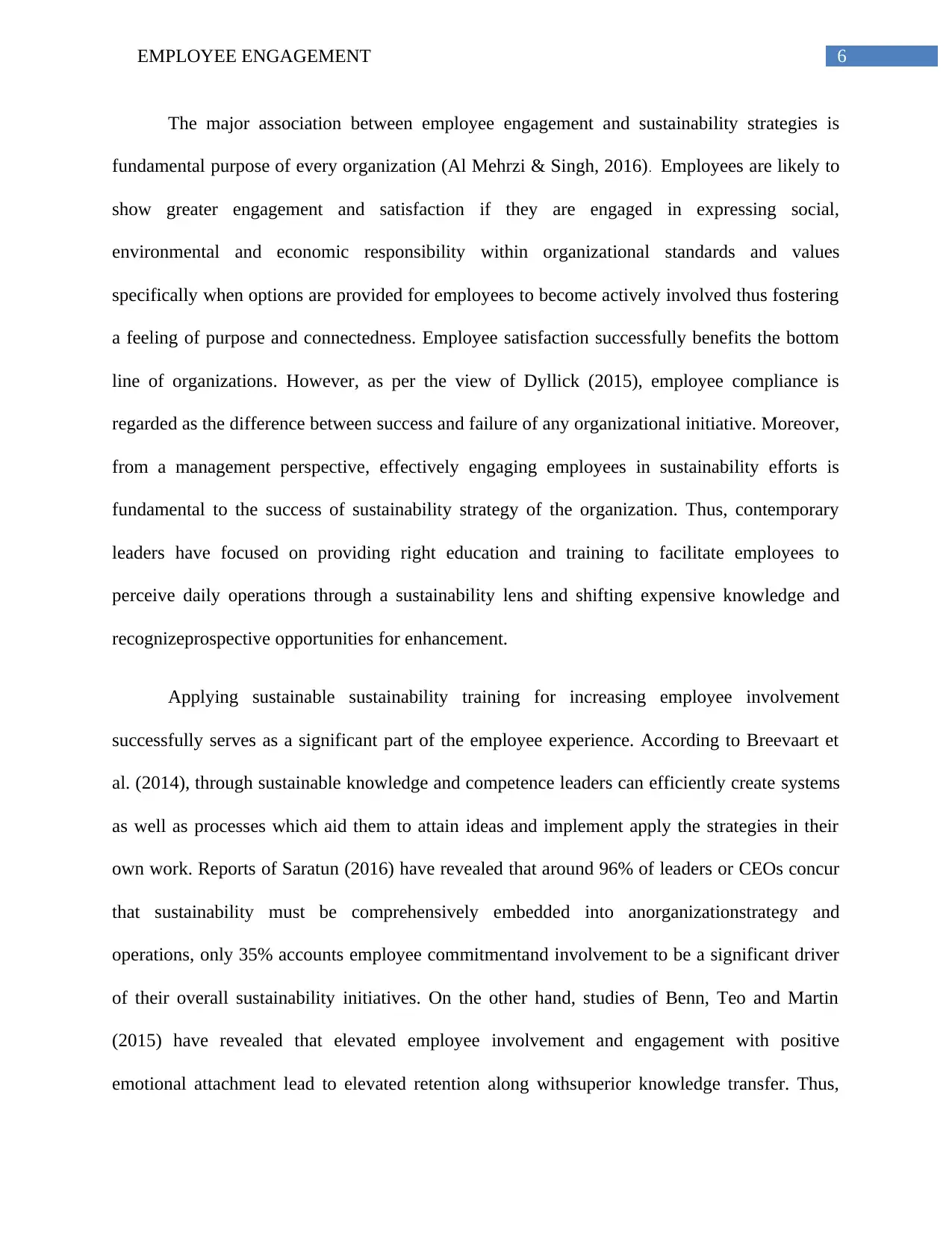
6EMPLOYEE ENGAGEMENT
The major association between employee engagement and sustainability strategies is
fundamental purpose of every organization (Al Mehrzi & Singh, 2016). Employees are likely to
show greater engagement and satisfaction if they are engaged in expressing social,
environmental and economic responsibility within organizational standards and values
specifically when options are provided for employees to become actively involved thus fostering
a feeling of purpose and connectedness. Employee satisfaction successfully benefits the bottom
line of organizations. However, as per the view of Dyllick (2015), employee compliance is
regarded as the difference between success and failure of any organizational initiative. Moreover,
from a management perspective, effectively engaging employees in sustainability efforts is
fundamental to the success of sustainability strategy of the organization. Thus, contemporary
leaders have focused on providing right education and training to facilitate employees to
perceive daily operations through a sustainability lens and shifting expensive knowledge and
recognizeprospective opportunities for enhancement.
Applying sustainable sustainability training for increasing employee involvement
successfully serves as a significant part of the employee experience. According to Breevaart et
al. (2014), through sustainable knowledge and competence leaders can efficiently create systems
as well as processes which aid them to attain ideas and implement apply the strategies in their
own work. Reports of Saratun (2016) have revealed that around 96% of leaders or CEOs concur
that sustainability must be comprehensively embedded into anorganizationstrategy and
operations, only 35% accounts employee commitmentand involvement to be a significant driver
of their overall sustainability initiatives. On the other hand, studies of Benn, Teo and Martin
(2015) have revealed that elevated employee involvement and engagement with positive
emotional attachment lead to elevated retention along withsuperior knowledge transfer. Thus,
The major association between employee engagement and sustainability strategies is
fundamental purpose of every organization (Al Mehrzi & Singh, 2016). Employees are likely to
show greater engagement and satisfaction if they are engaged in expressing social,
environmental and economic responsibility within organizational standards and values
specifically when options are provided for employees to become actively involved thus fostering
a feeling of purpose and connectedness. Employee satisfaction successfully benefits the bottom
line of organizations. However, as per the view of Dyllick (2015), employee compliance is
regarded as the difference between success and failure of any organizational initiative. Moreover,
from a management perspective, effectively engaging employees in sustainability efforts is
fundamental to the success of sustainability strategy of the organization. Thus, contemporary
leaders have focused on providing right education and training to facilitate employees to
perceive daily operations through a sustainability lens and shifting expensive knowledge and
recognizeprospective opportunities for enhancement.
Applying sustainable sustainability training for increasing employee involvement
successfully serves as a significant part of the employee experience. According to Breevaart et
al. (2014), through sustainable knowledge and competence leaders can efficiently create systems
as well as processes which aid them to attain ideas and implement apply the strategies in their
own work. Reports of Saratun (2016) have revealed that around 96% of leaders or CEOs concur
that sustainability must be comprehensively embedded into anorganizationstrategy and
operations, only 35% accounts employee commitmentand involvement to be a significant driver
of their overall sustainability initiatives. On the other hand, studies of Benn, Teo and Martin
(2015) have revealed that elevated employee involvement and engagement with positive
emotional attachment lead to elevated retention along withsuperior knowledge transfer. Thus,
Paraphrase This Document
Need a fresh take? Get an instant paraphrase of this document with our AI Paraphraser
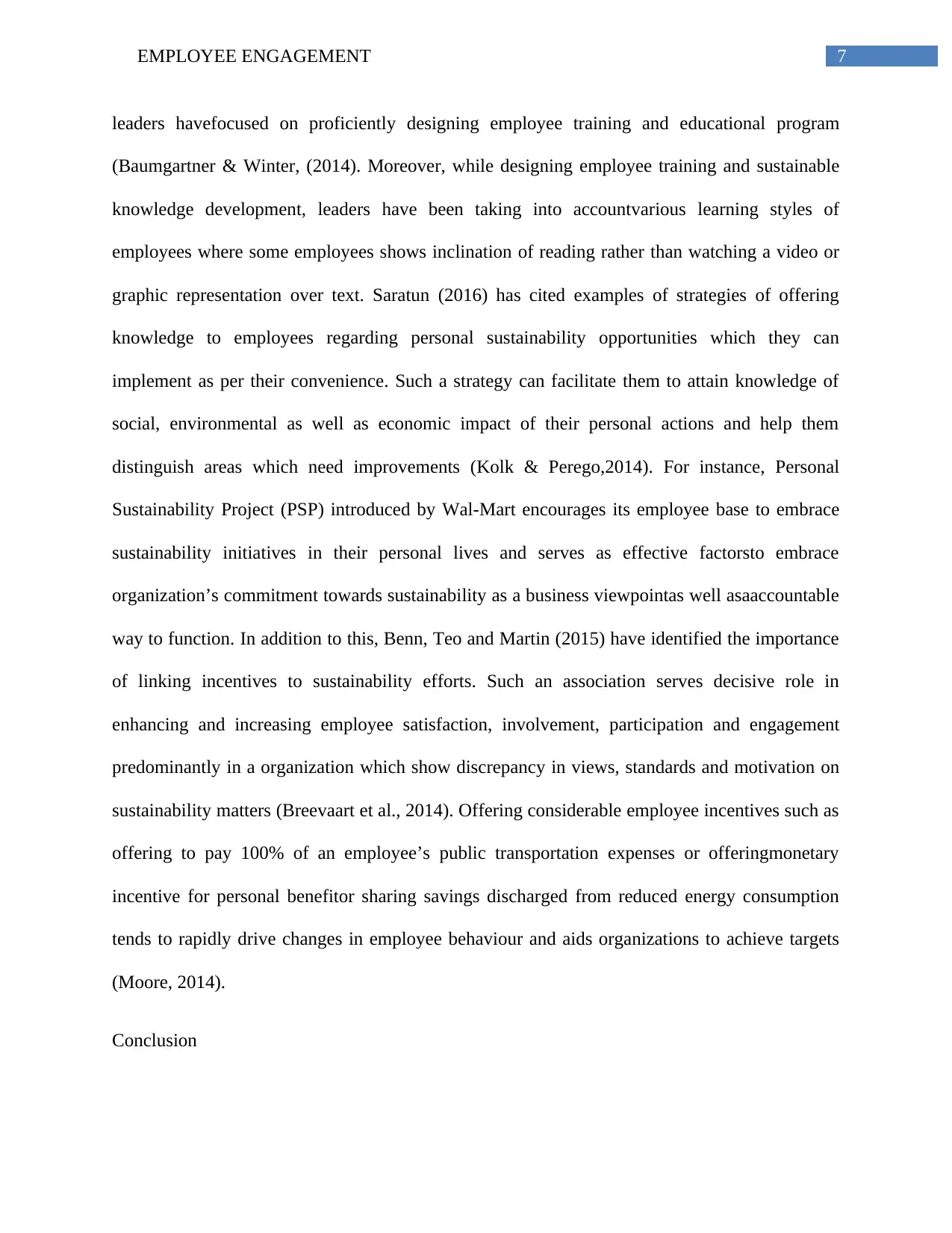
7EMPLOYEE ENGAGEMENT
leaders havefocused on proficiently designing employee training and educational program
(Baumgartner & Winter, (2014). Moreover, while designing employee training and sustainable
knowledge development, leaders have been taking into accountvarious learning styles of
employees where some employees shows inclination of reading rather than watching a video or
graphic representation over text. Saratun (2016) has cited examples of strategies of offering
knowledge to employees regarding personal sustainability opportunities which they can
implement as per their convenience. Such a strategy can facilitate them to attain knowledge of
social, environmental as well as economic impact of their personal actions and help them
distinguish areas which need improvements (Kolk & Perego,2014). For instance, Personal
Sustainability Project (PSP) introduced by Wal-Mart encourages its employee base to embrace
sustainability initiatives in their personal lives and serves as effective factorsto embrace
organization’s commitment towards sustainability as a business viewpointas well asaaccountable
way to function. In addition to this, Benn, Teo and Martin (2015) have identified the importance
of linking incentives to sustainability efforts. Such an association serves decisive role in
enhancing and increasing employee satisfaction, involvement, participation and engagement
predominantly in a organization which show discrepancy in views, standards and motivation on
sustainability matters (Breevaart et al., 2014). Offering considerable employee incentives such as
offering to pay 100% of an employee’s public transportation expenses or offeringmonetary
incentive for personal benefitor sharing savings discharged from reduced energy consumption
tends to rapidly drive changes in employee behaviour and aids organizations to achieve targets
(Moore, 2014).
Conclusion
leaders havefocused on proficiently designing employee training and educational program
(Baumgartner & Winter, (2014). Moreover, while designing employee training and sustainable
knowledge development, leaders have been taking into accountvarious learning styles of
employees where some employees shows inclination of reading rather than watching a video or
graphic representation over text. Saratun (2016) has cited examples of strategies of offering
knowledge to employees regarding personal sustainability opportunities which they can
implement as per their convenience. Such a strategy can facilitate them to attain knowledge of
social, environmental as well as economic impact of their personal actions and help them
distinguish areas which need improvements (Kolk & Perego,2014). For instance, Personal
Sustainability Project (PSP) introduced by Wal-Mart encourages its employee base to embrace
sustainability initiatives in their personal lives and serves as effective factorsto embrace
organization’s commitment towards sustainability as a business viewpointas well asaaccountable
way to function. In addition to this, Benn, Teo and Martin (2015) have identified the importance
of linking incentives to sustainability efforts. Such an association serves decisive role in
enhancing and increasing employee satisfaction, involvement, participation and engagement
predominantly in a organization which show discrepancy in views, standards and motivation on
sustainability matters (Breevaart et al., 2014). Offering considerable employee incentives such as
offering to pay 100% of an employee’s public transportation expenses or offeringmonetary
incentive for personal benefitor sharing savings discharged from reduced energy consumption
tends to rapidly drive changes in employee behaviour and aids organizations to achieve targets
(Moore, 2014).
Conclusion
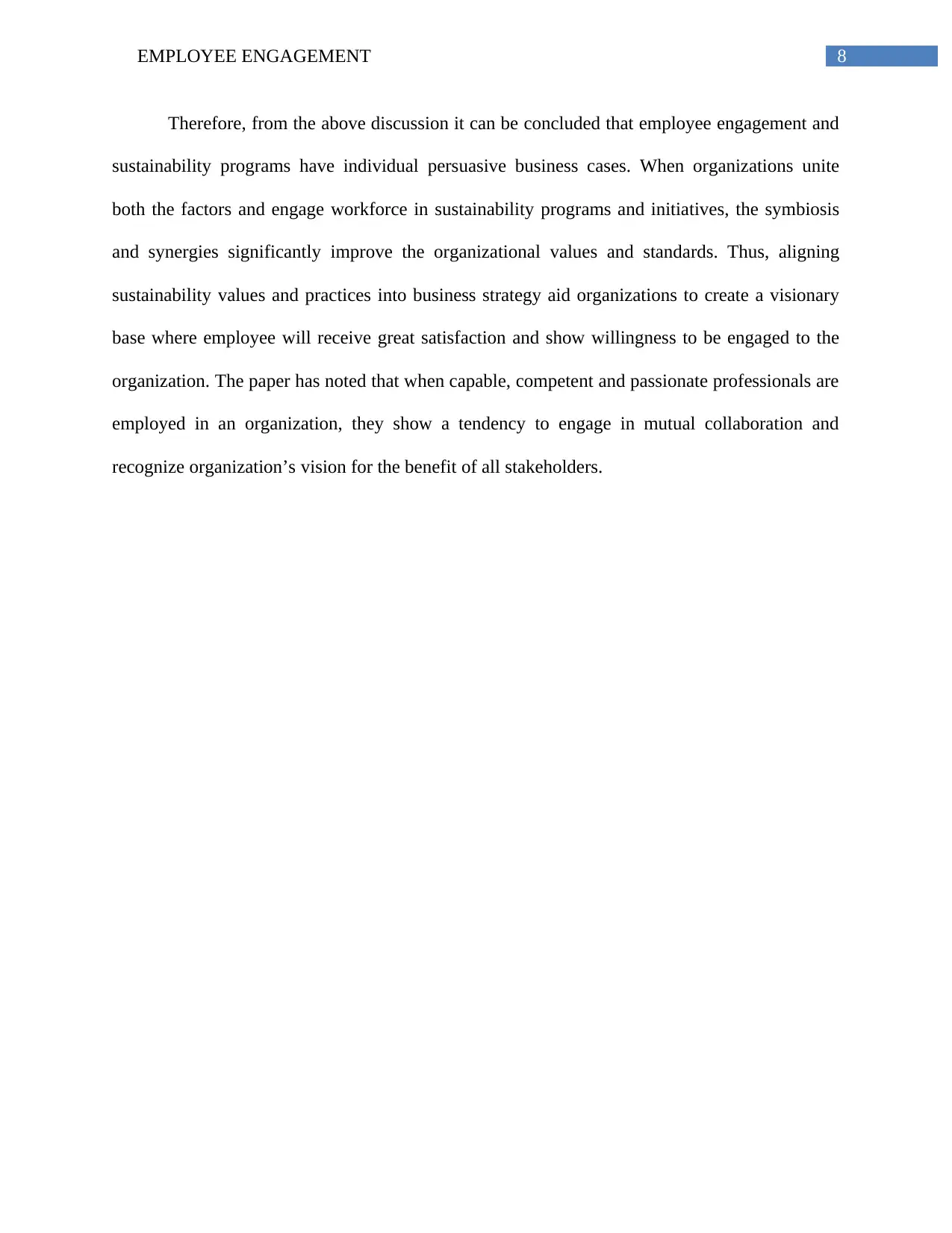
8EMPLOYEE ENGAGEMENT
Therefore, from the above discussion it can be concluded that employee engagement and
sustainability programs have individual persuasive business cases. When organizations unite
both the factors and engage workforce in sustainability programs and initiatives, the symbiosis
and synergies significantly improve the organizational values and standards. Thus, aligning
sustainability values and practices into business strategy aid organizations to create a visionary
base where employee will receive great satisfaction and show willingness to be engaged to the
organization. The paper has noted that when capable, competent and passionate professionals are
employed in an organization, they show a tendency to engage in mutual collaboration and
recognize organization’s vision for the benefit of all stakeholders.
Therefore, from the above discussion it can be concluded that employee engagement and
sustainability programs have individual persuasive business cases. When organizations unite
both the factors and engage workforce in sustainability programs and initiatives, the symbiosis
and synergies significantly improve the organizational values and standards. Thus, aligning
sustainability values and practices into business strategy aid organizations to create a visionary
base where employee will receive great satisfaction and show willingness to be engaged to the
organization. The paper has noted that when capable, competent and passionate professionals are
employed in an organization, they show a tendency to engage in mutual collaboration and
recognize organization’s vision for the benefit of all stakeholders.
⊘ This is a preview!⊘
Do you want full access?
Subscribe today to unlock all pages.

Trusted by 1+ million students worldwide
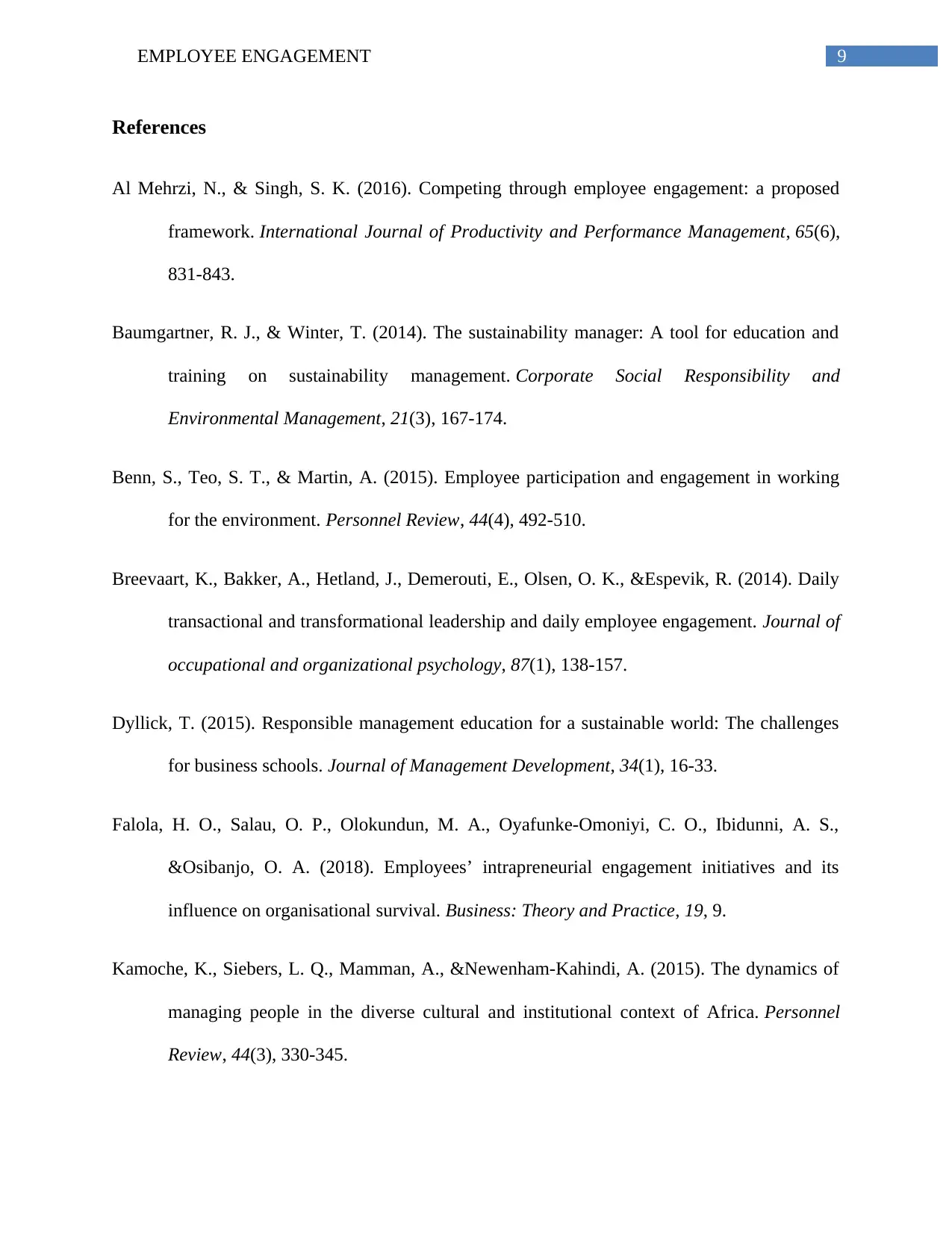
9EMPLOYEE ENGAGEMENT
References
Al Mehrzi, N., & Singh, S. K. (2016). Competing through employee engagement: a proposed
framework. International Journal of Productivity and Performance Management, 65(6),
831-843.
Baumgartner, R. J., & Winter, T. (2014). The sustainability manager: A tool for education and
training on sustainability management. Corporate Social Responsibility and
Environmental Management, 21(3), 167-174.
Benn, S., Teo, S. T., & Martin, A. (2015). Employee participation and engagement in working
for the environment. Personnel Review, 44(4), 492-510.
Breevaart, K., Bakker, A., Hetland, J., Demerouti, E., Olsen, O. K., &Espevik, R. (2014). Daily
transactional and transformational leadership and daily employee engagement. Journal of
occupational and organizational psychology, 87(1), 138-157.
Dyllick, T. (2015). Responsible management education for a sustainable world: The challenges
for business schools. Journal of Management Development, 34(1), 16-33.
Falola, H. O., Salau, O. P., Olokundun, M. A., Oyafunke-Omoniyi, C. O., Ibidunni, A. S.,
&Osibanjo, O. A. (2018). Employees’ intrapreneurial engagement initiatives and its
influence on organisational survival. Business: Theory and Practice, 19, 9.
Kamoche, K., Siebers, L. Q., Mamman, A., &Newenham-Kahindi, A. (2015). The dynamics of
managing people in the diverse cultural and institutional context of Africa. Personnel
Review, 44(3), 330-345.
References
Al Mehrzi, N., & Singh, S. K. (2016). Competing through employee engagement: a proposed
framework. International Journal of Productivity and Performance Management, 65(6),
831-843.
Baumgartner, R. J., & Winter, T. (2014). The sustainability manager: A tool for education and
training on sustainability management. Corporate Social Responsibility and
Environmental Management, 21(3), 167-174.
Benn, S., Teo, S. T., & Martin, A. (2015). Employee participation and engagement in working
for the environment. Personnel Review, 44(4), 492-510.
Breevaart, K., Bakker, A., Hetland, J., Demerouti, E., Olsen, O. K., &Espevik, R. (2014). Daily
transactional and transformational leadership and daily employee engagement. Journal of
occupational and organizational psychology, 87(1), 138-157.
Dyllick, T. (2015). Responsible management education for a sustainable world: The challenges
for business schools. Journal of Management Development, 34(1), 16-33.
Falola, H. O., Salau, O. P., Olokundun, M. A., Oyafunke-Omoniyi, C. O., Ibidunni, A. S.,
&Osibanjo, O. A. (2018). Employees’ intrapreneurial engagement initiatives and its
influence on organisational survival. Business: Theory and Practice, 19, 9.
Kamoche, K., Siebers, L. Q., Mamman, A., &Newenham-Kahindi, A. (2015). The dynamics of
managing people in the diverse cultural and institutional context of Africa. Personnel
Review, 44(3), 330-345.
Paraphrase This Document
Need a fresh take? Get an instant paraphrase of this document with our AI Paraphraser
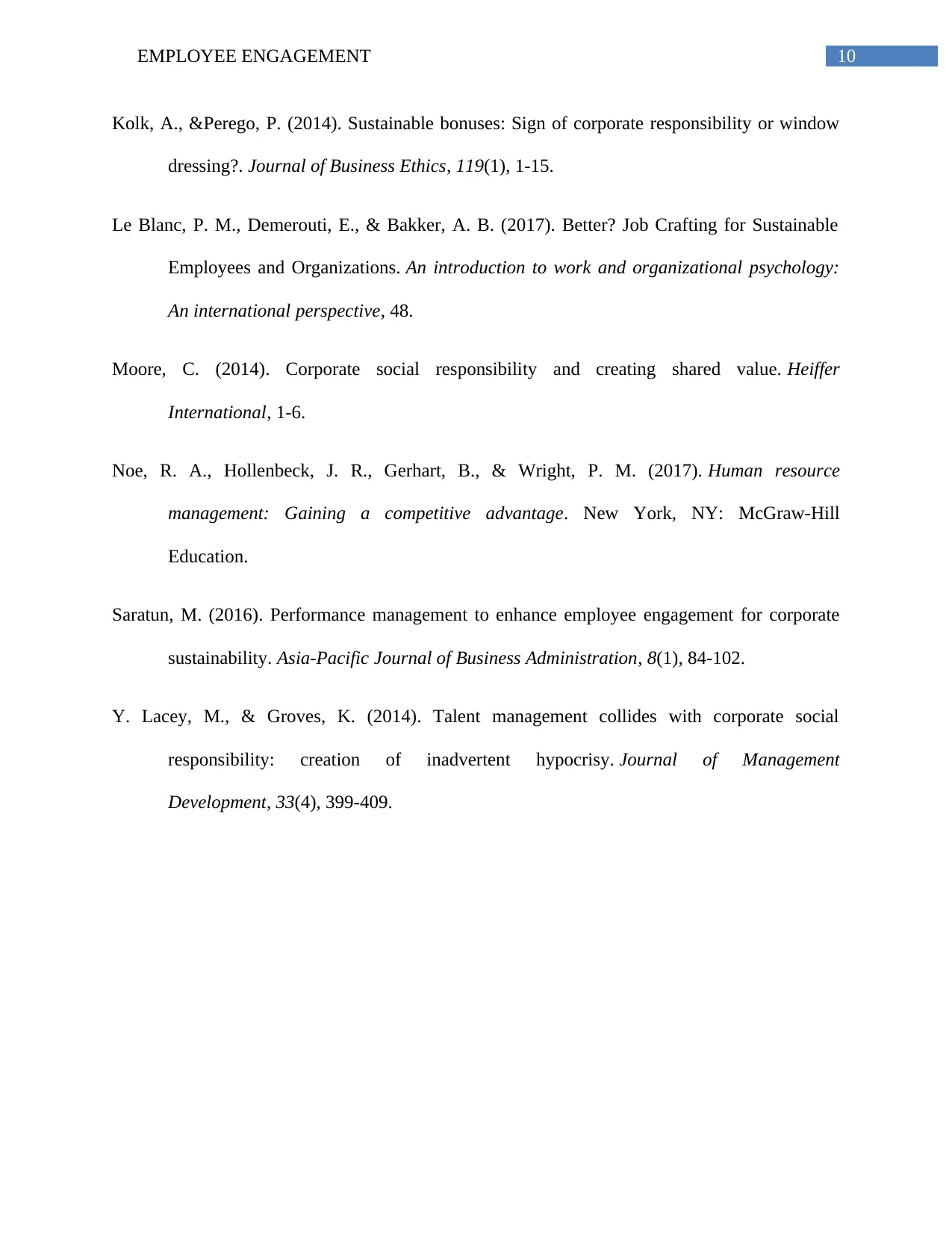
10EMPLOYEE ENGAGEMENT
Kolk, A., &Perego, P. (2014). Sustainable bonuses: Sign of corporate responsibility or window
dressing?. Journal of Business Ethics, 119(1), 1-15.
Le Blanc, P. M., Demerouti, E., & Bakker, A. B. (2017). Better? Job Crafting for Sustainable
Employees and Organizations. An introduction to work and organizational psychology:
An international perspective, 48.
Moore, C. (2014). Corporate social responsibility and creating shared value. Heiffer
International, 1-6.
Noe, R. A., Hollenbeck, J. R., Gerhart, B., & Wright, P. M. (2017). Human resource
management: Gaining a competitive advantage. New York, NY: McGraw-Hill
Education.
Saratun, M. (2016). Performance management to enhance employee engagement for corporate
sustainability. Asia-Pacific Journal of Business Administration, 8(1), 84-102.
Y. Lacey, M., & Groves, K. (2014). Talent management collides with corporate social
responsibility: creation of inadvertent hypocrisy. Journal of Management
Development, 33(4), 399-409.
Kolk, A., &Perego, P. (2014). Sustainable bonuses: Sign of corporate responsibility or window
dressing?. Journal of Business Ethics, 119(1), 1-15.
Le Blanc, P. M., Demerouti, E., & Bakker, A. B. (2017). Better? Job Crafting for Sustainable
Employees and Organizations. An introduction to work and organizational psychology:
An international perspective, 48.
Moore, C. (2014). Corporate social responsibility and creating shared value. Heiffer
International, 1-6.
Noe, R. A., Hollenbeck, J. R., Gerhart, B., & Wright, P. M. (2017). Human resource
management: Gaining a competitive advantage. New York, NY: McGraw-Hill
Education.
Saratun, M. (2016). Performance management to enhance employee engagement for corporate
sustainability. Asia-Pacific Journal of Business Administration, 8(1), 84-102.
Y. Lacey, M., & Groves, K. (2014). Talent management collides with corporate social
responsibility: creation of inadvertent hypocrisy. Journal of Management
Development, 33(4), 399-409.
1 out of 11
Related Documents
Your All-in-One AI-Powered Toolkit for Academic Success.
+13062052269
info@desklib.com
Available 24*7 on WhatsApp / Email
![[object Object]](/_next/static/media/star-bottom.7253800d.svg)
Unlock your academic potential
Copyright © 2020–2025 A2Z Services. All Rights Reserved. Developed and managed by ZUCOL.




